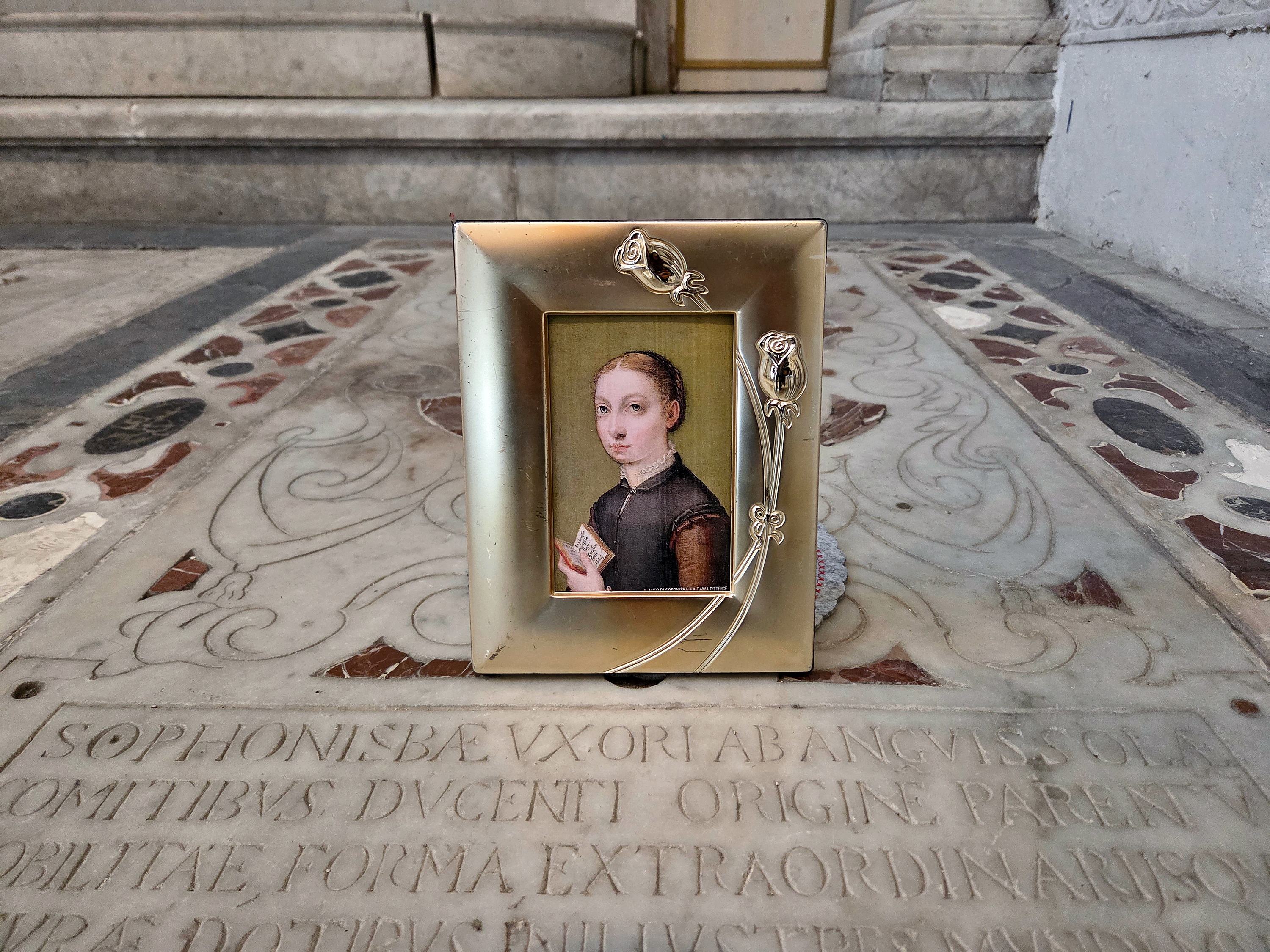She was mentored by Michelangelo, inspired Caravaggio and was described by Van Dyck as having taught him more than any other artist.
Yet few today have heard of Sofonisba Anguissola, the late-Renaissance painter described by her contemporary Giorgio Vasari, the art historian, as producing portraits “done so well that they appear to breathe”.
This weekend two towns in Sicily, where the artist spent parts of her life, are honouring Anguissola with celebrations to mark the 400th anniversary of her death — part of a renewed interest in her life and work, and a move to reinstate her as one of Italy’s great artists.
Anguissola is thought to have died in Palermo on November 16, 1625, at the age of 93, having spent her final decade in the Sicilian capital. She had previously lived in Paterno, a town on the southern flank of Mount Etna, during her first marriage.

A copy of an Anguissola self-portrait in the semi-abandoned church in Palermo where she was laid to rest

Paterno with Mount Etna in the background and the dome of the the Monastero della Santissima Annunziata church
ALESSIO MAMO FOR THE SUNDAY TIMES
On Saturday, Palermo marked the anniversary with a conference about her work, led by the art historian Alfio Nicotra, and a pilgrimage to her tomb in the church of San Giorgio dei Genovesi. Chiara Anguissola, a distant relative, laid a laurel wreath, a symbol of artistic achievement. “I feel so close to her, despite the 400 years,” she said.
Meanwhile, Paterno will mark the anniversary with a mass on Sunday for the artist and her first husband, the Paternese aristocrat Fabrizio Moncada. It will take place in the Monastero della Santissima Annunziata church, where two works by Anguissola hang.
“Paterno received so much from this woman,” said the local priest, Salvatore Patane, 56. “We have two of the most important works by Sofonisba.” The church’s two altarpieces — the Madonna dell’Itria and the Madonna della Raccomandata, the largest in the artist’s oeuvre — were both only attributed to Anguissola in recent years, after lying in plain sight for centuries.

Salvatore Patane near two of Sofonisba Anguissola’s paintings at the church
ALESSIO MAMO FOR THE SUNDAY TIMES
Patane, who describes himself as a feminist, is passionate about keeping Anguissola’s memory alive. Much of his decade in the parish has been devoted to promoting her work. He has formed a cultural association dedicated to the artist, and in 2024 created a chapel within the church to house her paintings, raising money through crowdfunding to do so.
“Sofonisba wasn’t just anybody,” he said. “She was a woman who managed to leave home and go to the most important court of the time.” Originally from Cremona, near Milan, Anguissola was invited by Philip II of Spain to Madrid, where she stayed for 14 years, before marrying Moncada and moving to Sicily.
“What a woman,” Patane added. “She is part of my life now.”
Patane prays for the soul of Fabrizio Moncada during mass on the 27th of each month, as requested by Anguissola when she gifted the Madonna dell’Itria painting to Paterno’s San Francesco convent after her husband’s death in 1578. “It sounds stupid, but I do it out of affection for this woman,” he said. “Normally we pray for Fabrizio and Sofonisba, but on Sunday we will pray for Sofonisba and Fabrizio.”

The Madonna dell’Itria painting
ALESSIO MAMO FOR THE SUNDAY TIMES

The exterior of the San Francesco convent
ALESSIO MAMO FOR THE SUNDAY TIMES
In Palermo, Anguissola’s tomb is cared for by a group of volunteers from the Touring Club Italiano. Since 2021, they have opened the semi-abandoned church on Thursday afternoons. Thought to be one of the finest examples of Renaissance architecture in Palermo, it had previously been closed for years.
“We knew little or nothing about Sofonisba when we opened — she was known by experts but not much by the general public,” said Fabio Rocca, 89, the group’s Palermo co-ordinator. “But we set out to spread the word about this artist … a female artist in a period when women were restricted. She was able to escape being locked up like women of her time.”
On Thursday evening, six volunteers led visitors to her tomb, where a copy of an Anguissola self-portrait in a gold frame sat on top of the loving inscription by her second husband, Orazio Lomellino, paying homage to her “extraordinary natural gifts”.
“Sofonisba paved the way for women,” said Grazia Collora, a volunteer. “She was an aristocrat — she could have stayed at home, been waited on, become a wife and mother, but she preferred an adventurous life. In the darkness of her era, she was the light.”

Fabio Rocca and Grazia Collora
Nicotra, the art historian from Catania in Sicily who has spent 30 years researching the painter, believes Anguissola is an important figure for Sicilians. “She wasn’t just an artist,” he said. “She was an aristocrat, an intellectual, a diplomat, and a promoter and commissioner of arts.”
• Female artists hit their peak in later life, says Tate director
Next year, the Palermo church will close for renovations, while in Paterno, a square will be named after Anguissola and a 14th-century altarpiece will be restored after a campaign by Patane’s cultural association.
“It’s a work that Sofonisba would have seen,” the priest said. “Paterno has received so much from this woman, and after 400 years she has given us another gift.”

